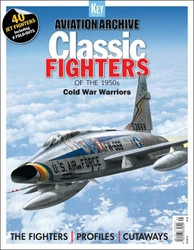| 01.11.2021, 14:42 | |||||
Автор книги: Allan Burney(Editor) 1950-е годы. Десятилетие, когда Элвис был королем, Мэрилин была королевой, и Спутник был запущен в космос. Это было также десятилетие реактивных истребителей. Под влиянием развивающейся холодной войны реактивные самолеты второго поколения летали дальше, быстрее и выше по мере того, как технологии были доведены до предела. Впереди была мощь авиационной промышленности США, отрасли, которая разжирела на военных заказах, но теперь отказывалась от господства на рынке, где награда за успех была высока, но цена неудач была еще выше. В эпоху американских кумиров над ними в небесах летали F-86 Sabre, противоречивый, но футуристический истребитель Starfighter и внушительный Thunderchief. По другую сторону Атлантики Великобритания по праву гордилась своим лидерством в области технологии реактивных двигателей и была полна решимости оставаться могущественной силой. Такие известные имена, как Supermarine, Gloster, de Havilland и Hawker создали типично своеобразные конструкции, включая Scimitar, Javelin (самолет, который выглядел одновременно и так правильно, и так неправильно), Sea Vixen и, конечно же, Hunter - поразительная грация и элегантность. В моде были гладкие линии, поэтому неудивительно, что французы обратились к Dassault для производства линейки стильных авангардных истребителей и эта традиция сохраняется и по сей день. Но реактивные истребители, которые создавали сверхзвуковые ударные волны по всему миру, несли красную звезду и прилетали с востока. После того, как британцы необъяснимо «подарили» Советскому Союзу технологию реактивных двигателей после Второй мировой войны, холодная война была ускорена мощью МиГа. То, что им не хватало утонченности, они восполнили характеристиками, и когда Sabre и МиГ столкнулись в небе Кореи, мир смотрел, затаив дыхание. В начале десятилетия «воздушные бои» все еще были в моде, но с появлением ракет класса «воздух-воздух» чистокровные реактивные истребители должны были нести все больше и больше боеприпасов. Скорость и маневренность уже не были так важны (хотя это все еще было выгодно), теперь все решали технологии, мощность и полезная нагрузка. И когда в раскаленном мерцании пламени форсажной камеры различие между истребителем и штурмовиком стало еще более размытым, мир погрузился в эпоху сверхзвуковых многоцелевых реактивных истребителей. Может ли быть в мире реактивных истребителей десятилетие более определяющее, чем 1950-е годы? The 1950s. A decade when Elvis was king, Marilyn was queen and Sputnik was launched into space. It was also the decade of the jet fighter. Driven by the developing Cold War, the second-generation of jets went further, faster and higher as technology was pushed to the limits. Leading the way was the might of the US aviation industry, an industry grown fat on the spoils of war but now scrapping over dominance in a market where the rewards for success were high, but the cost of failure was even higher. In an age of American idols, stars in their skies included the F-86 Sabre of Korean War fame, the controversial but futuristic Starfighter and the imposing might of the aptly named Thunderchief. Across the Atlantic, the UK was justly proud of its pioneering lead in jet engine technology and was determined to remain a powerful force. Famous names such as Supermarine, Gloster, de Havilland and Hawker created typically idiosyncratic designs including the Scimitar, the Javelin (an aircraft that looked so right and so wrong at the same time), the Sea Vixen (ditto) and, of course, the Hunter, all sweeping grace and elegance. With sleek lines all the rage, it was no surprise that the French should turn to Dassault to produce a range of stylish avant-garde fighters, a tradition that continues to this day. But the jet fighters that sent the greatest supersonic shock waves around the world carried a Red Star and came from the East. After the British had inexplicably ‘gifted’ jet engine technology to the Soviet Union after World War Two, the Cold War was accelerated by the might of the MiG. What they lacked in refinement, they made up for in performance and when the Sabre and MiG clashed over the skies of Korea, the world watched with bated breath. At the beginning of the decade, ‘dogfighting’ was still the rage, but with the rise of air-to-air missiles, thoroughbred jet fighters were asked to carry more and more ordnance. No longer was it all about speed and agility (though this was still advantageous), now it was all about technology, power and payload. And when the definition between fighter and attack aircraft became ever more blurred in the red-hot shimmer of afterburner flame, the world was thrust into the age of the supersonic multi-role jet fighter. Can there ever have been a more defining decade in the world of jet fighters than the 1950s? | |||||
|
| |||||
| | | |||||
| Всего комментариев: 0 | |
